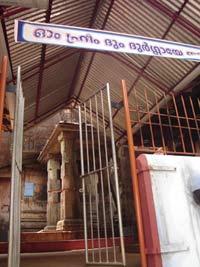Gavi Eco-Tourism a project of the Kerala Forest Development Corporation has caught the attention of tourists, mostly from European countries. The project is exclusive in many respects and the majority who visited was nature lovers and adventure tourists. Over a short period of time visitors to Gavi gradually increased, especially after 'Alistair International' the world acclaimed tourism major listed it among the leading eco-tourism centres and one of the must-see places in India.
A highlight of the Gavi eco project is the involvement of the local populace in its activities as guides, gardeners and cooks. This will provide livelihood for the locals and also will help to create awareness on conservation of nature. Gavi, located in Pathanamthitta district offers its visitors activities like trekking, wildlife watching, outdoor camping in specially built tents, and night safaris.
The road leading to the picturesque Gavi is blanketed by tea plantations, which itself is a refreshing experience. En route to Gavi are places of interest like Mundakayyam, Kuttikanam, Peermedu and Vandiperiyar from where the road deviates to Gavi.
A highlight of the Gavi eco project is the involvement of the local populace in its activities as guides, gardeners and cooks. This will provide livelihood for the locals and also will help to create awareness on conservation of nature. Gavi, located in Pathanamthitta district offers its visitors activities like trekking, wildlife watching, outdoor camping in specially built tents, and night safaris.
The road leading to the picturesque Gavi is blanketed by tea plantations, which itself is a refreshing experience. En route to Gavi are places of interest like Mundakayyam, Kuttikanam, Peermedu and Vandiperiyar from where the road deviates to Gavi.
Once you reach Gavi the serene eco-lodge 'Green Mansion' awaits you like a fairy to embrace you in its protective fold. From the 'Green Mansion', one can savour the spectacular view of the Gavi Lake and the adjoining forests. Besides the accommodation provided in 'Green Mansion' visitors can also try out the tree houses here and can even pitch tents amidst the wilderness. Here one can have outstanding trekking experiences, which are overseen by trained local people. Those who would love to be left alone can do so in the tranquil environs of Gavi or may even go canoeing in the placid waters of the lake or enjoy a breathtaking sunset. Visitors are usually provided vegetarian food and snacks, which further adds to the eco-friendly ambiance of the place.
The place is rich in flora and fauna. There are hills and valleys, tropical forests, sprawling grasslands, sholas, cascading waterfalls and cardamom plantations. Endangered species including the Nilgiri Tahr and Lion-tailed macaque are often sighted at the outskirts of Gavi. With more than 260 species of birds including the great pied hornbill, woodpecker, and kingfishers, Gavi is a heaven for birdwatchers.
Some of the breathtaking viewpoints at Gavi like the Valley View offer spectacular view of a deep ravine and the forest below. From Kochu Pampa, a point near Green Mansion eco-lodge one can track the grazing Nilgiri Tahrs.
The famous pilgrim destination, Sabarimala is a short trek from Gavi. For those interested in observing the nocturnal wildlife, night safaris to Kullur, Gavi Pullumedu, Kochu Pampa, Pachakanam provide ample opportunities for wildlife viewing.
Another unique feature of Gavi is camping in the forests. One can pitch a tent in the camping site, which is a rarity in many Indian forests. As the dusk stretches into the silence of the night, one can feel the presence of wildlife in the middle of nowhere, an experience that cannot be explained in words. There are also tree top houses where one can enjoy the avian life to the fullest.
Active involvement of tribals in Gavi makes it a unique venture of its kind in the country. Traditional knowledge of the forest and its way of life helps Gavi to sustain its surroundings in its original state.
Gavi is bound to cast its magical spell on every visitor and is surely a place that should not be missed in one's lifetime. Gavi is pristine, and it belongs to the wild, which is a reminder that visitors are responsible for their intentions and actions, which will have a bearing on the upkeep of Gavi for a long time to come.
Location:
Location:
Gavi is located about 28 km from Vandiperiyar, which is 18 km from Thekkady.
Nearest railway station: Kottayam, about 114 km away.
Nearest airports: Madurai Airport (Tamil Nadu), about 140 km away; Cochin International Airport, about 190 km away.
Contact AddressPeriyar Tiger Reserve.
Eco-Tourism Project Periyar.
For more details please contact:
Tourist Information Office
Department of Tourism, Thekkady
Phone: 04869-222620
Nearest railway station: Kottayam, about 114 km away.
Nearest airports: Madurai Airport (Tamil Nadu), about 140 km away; Cochin International Airport, about 190 km away.
Contact AddressPeriyar Tiger Reserve.
Eco-Tourism Project Periyar.
For more details please contact:
Tourist Information Office
Department of Tourism, Thekkady
Phone: 04869-222620







.jpg)

















